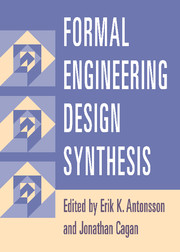Book contents
- Frontmatter
- Contents
- Contributing Authors
- Foreword
- Preface
- Introduction
- 1 Vitruvius Redux
- 2 How to Calculate with Shapes
- 3 Engineering Shape Grammars
- 4 Creating Structural Configurations
- 5 Microsystem Design Synthesis
- 6 Function-Based Synthesis Methods in Engineering Design
- 7 Artificial Intelligence for Design
- 8 Evolutionary and Adaptive Synthesis Methods
- 9 Kinematic Synthesis
- 10 Systematic Chemical Process Synthesis
- 11 Synthesis of Analog and Mixed-Signal Integrated Electronic Circuits
- 12 Mechanical Design Compilers
- 13 Scientific Discovery and Inventive Engineering Design
- Index
13 - Scientific Discovery and Inventive Engineering Design
Published online by Cambridge University Press: 10 October 2009
- Frontmatter
- Contents
- Contributing Authors
- Foreword
- Preface
- Introduction
- 1 Vitruvius Redux
- 2 How to Calculate with Shapes
- 3 Engineering Shape Grammars
- 4 Creating Structural Configurations
- 5 Microsystem Design Synthesis
- 6 Function-Based Synthesis Methods in Engineering Design
- 7 Artificial Intelligence for Design
- 8 Evolutionary and Adaptive Synthesis Methods
- 9 Kinematic Synthesis
- 10 Systematic Chemical Process Synthesis
- 11 Synthesis of Analog and Mixed-Signal Integrated Electronic Circuits
- 12 Mechanical Design Compilers
- 13 Scientific Discovery and Inventive Engineering Design
- Index
Summary
INTRODUCTION
Michael Faraday was a scientist and an inventor. It was the same piece of work, the discovery that a magnetic field could generate electricity, and the resultant invention of the electric generator, that entitled him to both of these appellations. The goal of this chapter is to explain how a single piece of work could qualify him for both titles, and more importantly how these seemingly disparate activities are surprising similar. To do this we will attempt to delineate the domains of invention and discovery, showing how they are structured and how the underlying cognitive processes that generate both activities are broadly equivalent, even though their goals may differ. It is our contention that the activities that are commonly included in design creation and scientific discovery are often heavily intertwined, have similarly structured domains, are accomplished by very similar cognitive activities, can be simulated or emulated by similar computational models, and, many times, even yield similar artifacts, processes, or knowledge. In these latter cases, not only do they have similarly structured domains and equivalent mechanisms, but their outputs can be viewed both as invention and as discovery. With regard to Faraday, it was the invention of the electric generator (motor) and discovery of magnetism – electricity equivalency that entitles him to his dual status as inventor and scientist.
This book focuses on formal methods for design synthesis, with “formal” implying approaches that are driven by specified goals and computationally realized.
- Type
- Chapter
- Information
- Formal Engineering Design Synthesis , pp. 442 - 465Publisher: Cambridge University PressPrint publication year: 2001
- 5
- Cited by



